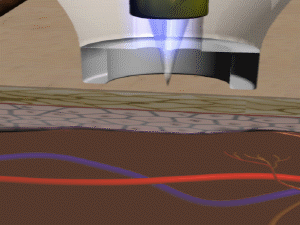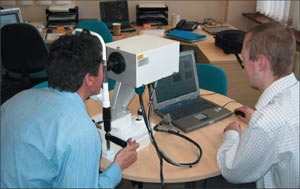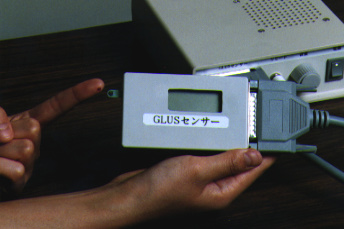
An LED-based glucose detection system is set to make life less painful for diabetics
US medical device maker, MicroSense International, has developed a near-ultraviolet LED-based device that detects glucose levels without drawing blood from the patient. The system consists of a 20 µm-tipped fiber-optic probe that is attached to a hand-held meter. Coated with an enzyme layer and fluorescent dye, the probe is tailored to measure glucose levels in the interstitial fluid just beneath the skin's outer layers when stimulated with the near-ultraviolet light.
To take measurements, a patient inserts the probe just 100µm into the skin for up to 20 s. According to MicroSense's chief executive William Edelman, 100µm marks the boundary of the tissue zone that contains the glucose marker. This 100µm depth is also above the nerve endings, which makes the procedure painless. The mechanics of the device control this parameter because an incorrect depth will give an incorrect reading. Claiming that the device is as accurate as today's invasive techniques Edelman says that MicroSense plans to target Pushita worldwide. 1
Optical glucose sensor holds promise for diabetics and intensive care patients
SANTA CRUZ, CA (USA)--Researchers at the University of
California, Santa Cruz, have developed a novel optical
glucose sensor that could be used to provide continuous
monitoring of glucose levels in diabetics and
hospitalized patients.Recently published studies showed
that the sensor detects glucose under physiological
conditions, giving a reversible fluorescent signal that
changes intensity in response to changes in the
concentration of glucose.
The optical glucose sensor consists of a fluorescent chemical complex immobilized in a 'thin-film hydrogel.' The hydrogel, a biocompatible polymer similar to that used to make soft contact lenses, is permeable to glucose. The sensing system has two components: a fluorescent dye and a 'quencher' that is responsive to glucose. In the absence of glucose, the quencher binds to the dye and prevents fluorescence, while the interaction of glucose with the quencher leads to dissociation of the complex and an increase in fluorescence.
The results
showed that the system functions as a continuous glucose
monitor capable of operating under physiological
conditions. The sensor shows outstanding glucose
response over the full range of glucose levels that
might occur in a diabetic.2
Eye sensor offers instant blood glucose readings
A pain-free optical technique for measuring blood glucose levels could prove to be a big hit with diabetics when it comes to the market. Oliver Graydon reports from Photonex 2005.
Taking blood
glucose measurements could be as simple
as holding a small sensor up to a
person's eye and pressing a button if a
UK start-up is successful. Lein Applied
Diagnostics is developing a hand-held
optical sensor that determines the
glucose level of a person with diabetes
via the eye's aqueous humour.

The attraction of the technique is that it involves no drawing of blood, takes just 0.1 s to perform, and potentially requires no consumables aside from a battery. In contrast, glucose measurements are currently performed by pricking the finger and placing a finger stick with a blood sample into a small analyser four or five times a day. The problem with this approach is that is painful, inconvenient and can be unhygienic.3




